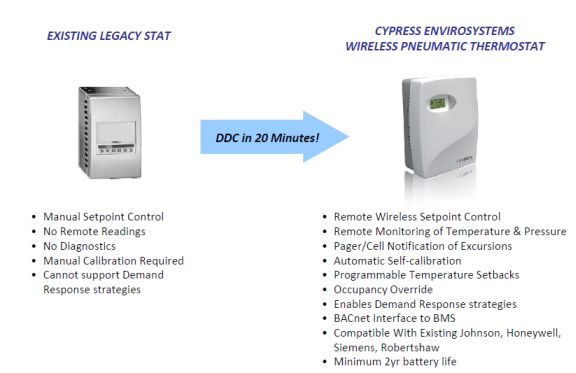Connect Buildings to Smart Grid
Commercial Buildings – Solutions
Overview
A key part of Smart Grid deployment is the introduction of “dynamic pricing”, which means that the price of electricity can change over time. During periods of high demand, the price per kWh can go up seven or ten times normal rates to discourage use. This is particularly relevant for commercial buildings which, with higher HVAC load on hot summer afternoons, can account for over half the peaking load on the electrical grid.
When smart buildings are connected to the Smart Grid, they can “listen” to pricing signals transmitted from the utility, and automatically adjust thermostat setpoints to minimize electrical use during peak periods (this functionality is called Auto-Demand Response, or A-DR). This kind of intelligent response from smart buildings can help reduce energy costs, and also lessen the load on the grid.
The Challenge
Unfortunately, the majority of commercial buildings in use today are not smart. Most still use pneumatic (compressed air) HVAC controls. This means that they cannot automatically respond to A-DR signals, and may incur significant energy bills as a result.
Retrofitting these buildings involve opening up walls and ceilings–potentially exposing harmful substances such as asbestos–to replace HVAC actuators and run wires. The initial cost is high, the disruption to occupants is often unacceptable, and the payback period is usually five years or more. As a result, retrofits have not been very popular. In fact, over 60 billion sq-ft of commercial building space today still use legacy HVAC controls and cannot respond to demand events.
The Cypress Envirosystems Solution
The patent-pending Wireless Pneumatic Thermostat solution provides a cost-effective, easy-to-install retrofit solution for existing pneumatic HVAC thermostats. During hot summer afternoons for example, the WPTs can be programmed to increase temperature setpoints by two degrees, thereby reducing chiller or air-handler electrical consumption. Typically, reductions of 0.5 kW to 1.0 kW per 1,000 square feet can be achieved during a demand event with the WPT.
The WPTs can be installed in minutes without opening up walls or ceilings, and cost 80% less than a conventional “smart” retrofit. It includes a built-in OpenADR communication interface used by most utilities to send pricing or demand response signals, and qualifies for incentive payments in many states. The payback period is typically under 18 months.
 |
Case Studies


